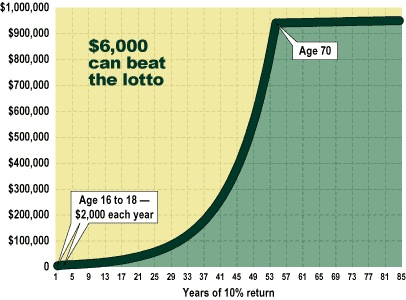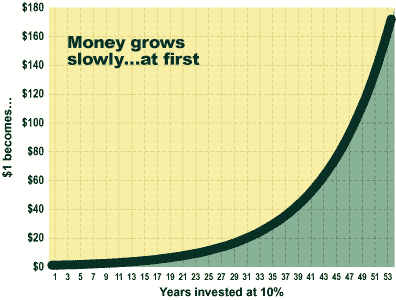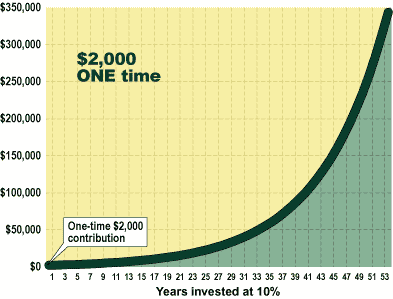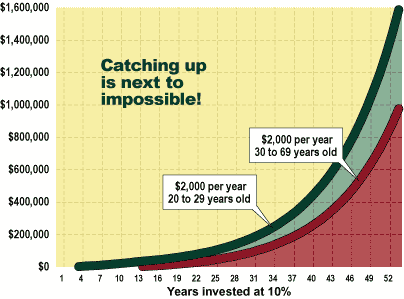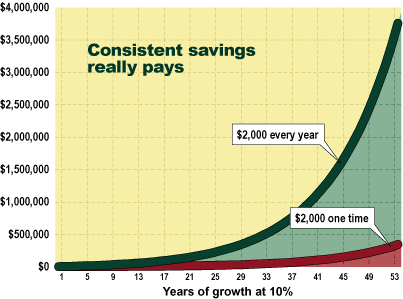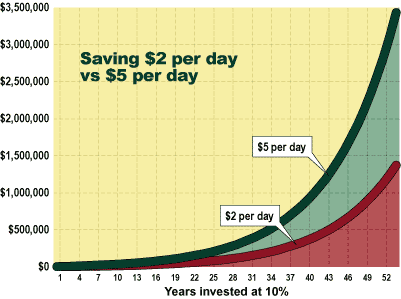
HOT TOPICS LIST
- Strategies
- Stocks
- Buy
- Investing
- Brokers
- Psychology
- Interviews
- Accumulate
- Sell
- Hold
- Spotlight
- Websites
- Candlestick Corner
- Gold & Metals
- Options Trading
LIST OF TOPICS
MONEY MANAGEMENT
The Money Tree Grows Slowly -- At First
01/26/01 12:04:21 PM PSTby Bruce R. Faber
Face it. Odds are you will never win the lottery. With a little foresight, though, you can retire in style -- with even more monthly income than you would have if you picked the winning numbers in a million-dollar jackpot. Here's how.
| If someone came up to you and said, "Give me $6,000 over three years and I promise that you will win a million-dollar lottery," you would do whatever it took to come up with $6,000, right? Yet the reward from that winning ticket would not even approach the earnings you could expect if you invested just $6,000 early on. If you win a million dollars in most state-sponsored lotteries, you get paid $50,000 a year -- less than $4,200 a month -- for 20 years. But if you were to invest $6,000 over three years as a teenager, you could pretty much ensure yourself a comfortable life in your golden years. Let me put this another way. If you deposited just $2,000 on your 16th, 17th, and 18th birthdays, then on the day you turned 70, you could start taking out $7,900 every month forever! (Or as long as you want to take money out. See Figure 1.) Can you imagine how rich you would be if you funded your IRA for five or 10 of your early years, instead of only three? If you're going to gamble on your future, at least bet on that old, slow-growing money tree.
GET STARTED ALREADY! My point is this: The longer your money has to work, the better chance it has of making you rich. As an example, let's take a single dollar, one lousy buck (OLB for short), and put it to work at a 10% return. (Follow along in Figure 2.) I'm using the 10% rate for a couple of reasons. It is neither overly conservative nor overly optimistic, and it is what the market has traditionally returned.
Let's look further at the progress of OLB and earned interest over the coming years. At the end of year 2, OLB is still OLB, but it has spawned another dime. More important than the 20 cents is the fact that the first year's earned interest has also grown by 10%, an entire penny. It may not be much, but it is interest earned on interest, and that, as Willie Sutton said of banks, is where the money is. That penny represents what is referred to as compound interest. COMPOUND INTEREST, THE GROWTH HORMONE Now we've come to the heart of the matter. Compound interest is the magic of savings. It is not OLB that is going to make the money tree grow; OLB is but the seed. And the growth hormone that is going to encourage money production is not even the earned interest that comes directly from OLB. That will remain a single dime every year. OLB will always be one lousy buck. (In reality, OLB will shrink dramatically in worth due to inflation. For details, see my article in the January/February 2001 issue of Working Money.) In 50 years, OLB will produce only $5 in additional growth as earned interest. In 50 years, OLB and all of the earned interest that OLB directly produces will total $6. That's not much of a money tree. But don't despair! Read on: Money works slowly. Let's take stock. After two full years of saving, we have only OLB, two dimes of earned interest and one single penny of compound interest. Though only a penny, it is a most exciting penny, and here's why. While OLB will always be just OLB, and the interest earned by OLB itself is fixed at a dime per year, compound interest will grow over time. It is the growth hormone of savings, and its secret weapon. In two years, compound interest produces just a penny, but at the end of three years, compound interest amounts to three cents. That's still not much money, you say. And you're right. However, while OLB remains the same and earned interest is fixed, the compound interest in your savings has doubled in one year. Yes! Your one penny has been joined by two new ones, and together, they are now three. Still, at this rate, it will be some time in year 9 before OLB and its 80 cents -- 80 cents! -- of earned interest, plus the compound interest, will reach $2. Even though it takes more than nine years for OLB and its friends to increase by the first dollar, by halfway through year 12 the $3 mark is reached; the interest is compounding. Finally, that money tree is starting to reach out to the sky with multiple branches and putting down roots. Finally, the compound interest starts to grow at ever-increasing speed. No, "speed" isn't the right word here. Perhaps "increasing rate" would be a more accurate term. After all, the money works slowly -- at first. IT TAKES A WHILE TO PUT DOWN DEEP ROOTS As a matter of fact, OLB and friends are into year 27 before they even increase by a whole dollar in less than one year. At that point, there is good ol' OLB and $2.70 in fixed earned interest. By now, though, that one penny of compound interest that we had at the end of year 2 has multiplied over 800 times and now supplies $8.22. So at that point, the total you have is $11.92. As slow as this seems, it is obvious that compound interest is the lifeforce that feeds the money tree. By year 34 -- finally! -- compound interest is increasing by a dollar in less than six months. Now we're picking up speed -- so to speak. The total, $23.23, is now beginning to demonstrate the tremendous power of compound interest. While it took 34 years for OLB and friends to grow $2 in a single year, only seven years later -- in year 41 -- that total climbs to more than $4 per year. Did I hear you say: "Big deal! Four stinking dollars for a whole year"? Look at it this way. If you had the foresight, persistence, and intelligence to fund your IRA to the maximum allowable $2,000 that first year, then that $4 represents $8,000 this year alone. (See Figure 3.) Depending on when you started, there are still several years of increasingly profitable growth ahead. For every OLB saved the first year, by year 41, you have $45.26. That money tree is beginning to produce some blossoms and even some edible fruit.
Another seven years down the road, OLB and friends are producing more than $8 per year. At the end of 48 years of compounding at 10%, you have $88.20 in your IRA for every OLB you invested on that day long ago. Even for the person who started saving on his or her 20th birthday, the rewards upon reaching the retirement age of 70 are very attractive. The money tree is full of ripe fruit and even more blooms. Every OLB saved at the beginning has now produced $5 of earned interest and $111.29 of compound interest! At this point, it is truly obvious that money does work. START EARLY AND CONTRIBUTE OFTEN
Just for the fun of it, let's suppose that instead of purchasing fancy sneakers and video games, you were smart enough to work hard and put together $2,000 to drop into an IRA on your 16th, 17th, and 18th birthdays. You are now 70 and every OLB you planted is worth between $142.04 and $171.87. That $6,000 you worked so hard for, that you gave up so much for, just to put it in your IRA, that money your friends chided you about not spending on a car, is now worth $940,324! Money works slowly, but it does work! While these numbers are based on your money tree growing at a simple 10% a year, there are many investment gurus that feel a return of 15% is entirely reasonable. At 15% instead of 10%, you should have half again as much, right? Major wrongo. If, and this is a very big if, your return on that $6,000 investment were 15% instead of 10% -- maybe you should sit down and take a deep breath -- then that $6,000 seed could become a $9,953,136 money tree. When the time comes, you could start taking out a tad over $4,000 a day for a very long time. Money works! Regarding your very own money tree, to paraphrase a line from a movie, "If you plant it, it will grow."
MONEY WORKS, BUT SLOOOOOOWLY The money tree article shows the advantages of putting $6,000 in your IRA over three years. That might be a little rich for your blood -- how many teenagers have access to $6,000? -- so let's make it easy for you. How about if all you put in is less than the cost of a McDonald's Value Meal, less than a pack of cigarettes, less than a beer, even less than a good-sized latte -- how about two bucks a day? Even at minimum wage, you can be a millionaire at age 70. In fact, you can be more than a millionaire, assuming you get the 10% return used as a basis in my articles. There are 365 days in the average year. Multiply 365 by your two hard-working dollars, and you have $730. If you open an IRA with a deposit of $730 on your 16th birthday and add $2 a day until your 70th birthday, you'd have $1,372,832! You can then start taking out $383 every day for the rest of your life. Not bad for scrimping for a bit. In other words, every two days you will be able to take out more than 100% of what you put in each preceding year! Even if you worked for minimum wage all your life, your money obviously didn't. The current minimum wage is something over $5 per hour. If you worked your entire life for $6 per hour and put just $2 a day into that IRA I've been talking about, your lousy two bucks a day would have made twice as much money as you did! Money works slowly, but boy, does it work. But here's something else to remember. According to the Savings Coalition of America, our savings rate in the US is not just bad, it is atrocious! Personal savings is one wheel of the tricycle that carries us into our second childhood -- you know, where we eat, sleep, play, and don't have to work. You're in for a rough ride if that wheel is absent or broken. This is especially true for young people today, as the other two wheels of that tricycle are company pensions and Social Security. Pensions? Social Security? Need I say more? The bottom line? Whatever your age, you need to start stashing some of your earnings in a savings account that gives you a decent return.
|
| Title: | Staff Writer |
| Company: | Technical Analysis, Inc. |
| Address: | 4757 California Ave. SW |
| Seattle, WA 98116 | |
| Phone # for sales: | 206 938 0570 |
| Fax: | 206 938 1307 |
| Website: | traders.com |
| E-mail address: | BFaber@traders.com |
Traders' Resource Links | |
| Charting the Stock Market: The Wyckoff Method -- Books | |
| Working-Money.com -- Online Trading Services | |
| Traders.com Advantage -- Online Trading Services | |
| Technical Analysis of Stocks & Commodities -- Publications and Newsletters | |
| Working Money, at Working-Money.com -- Publications and Newsletters | |
| Traders.com Advantage -- Publications and Newsletters | |
| Professional Traders Starter Kit -- Software | |
PRINT THIS ARTICLE

|

Request Information From Our Sponsors
- StockCharts.com, Inc.
- Candle Patterns
- Candlestick Charting Explained
- Intermarket Technical Analysis
- John Murphy on Chart Analysis
- John Murphy's Chart Pattern Recognition
- John Murphy's Market Message
- MurphyExplainsMarketAnalysis-Intermarket Analysis
- MurphyExplainsMarketAnalysis-Visual Analysis
- StockCharts.com
- Technical Analysis of the Financial Markets
- The Visual Investor
- VectorVest, Inc.
- Executive Premier Workshop
- One-Day Options Course
- OptionsPro
- Retirement Income Workshop
- Sure-Fire Trading Systems (VectorVest, Inc.)
- Trading as a Business Workshop
- VectorVest 7 EOD
- VectorVest 7 RealTime/IntraDay
- VectorVest AutoTester
- VectorVest Educational Services
- VectorVest OnLine
- VectorVest Options Analyzer
- VectorVest ProGraphics v6.0
- VectorVest ProTrader 7
- VectorVest RealTime Derby Tool
- VectorVest Simulator
- VectorVest Variator
- VectorVest Watchdog

